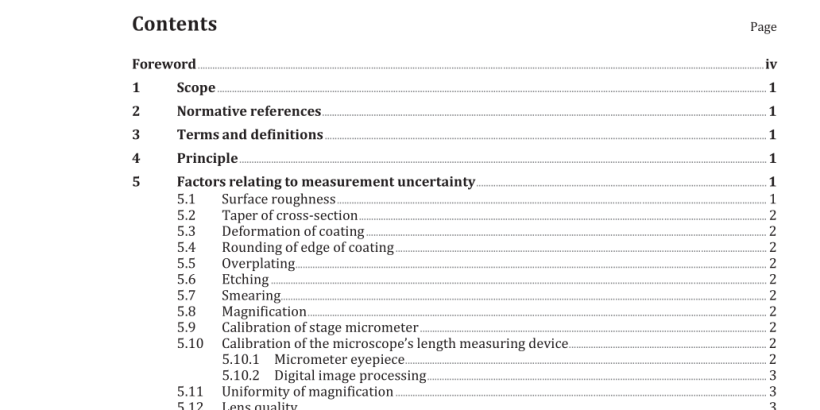ISO 1463:2021 pdf download – Metallic and oxide coatings — Measurement of coating thickness — Microscopical method.
5.2 Taper of cross-section If the plane of the cross-section is not perpendicular to the plane of the coating, the measured thickness will be greater than the true thickness, e.g. an inclination of 10° to the perpendicular will contribute a 1,5 % uncertainty. NOTE B.1 provides guidance on the taper of a cross-section. 5.3 Deformation of coating Detrimental deformation of the coating can be caused by excessive temperature or pressure during mounting and preparation of cross-sections of soft coatings or coatings that melt at a low temperature, and also by excessive abrasion of brittle materials during preparation of cross-sections. 5.4 Rounding of edge of coating If the edge of the coating cross-section is rounded, i.e. if the coating cross-section is not completely flat up to its edges, the true thickness cannot be observed microscopically. Edge rounding can be caused by improper mounting, grinding, polishing or etching. It is usually minimized by overplating the test specimen before mounting (see A.2 ). 5.5 Overplating Overplating of the test specimen protects the coating edges during preparation of cross-sections and thus prevents erroneous measurement. Removal of coating material during surface preparation for overplating can result in a low thickness measurement. 5.6 Etching Optimum etching produces a clearly defined and narrow dark line at the interface of two metals. Excessive etching produces a poorly defined or wide line that can result in erroneous measurement.
5.10.2 Digital image processing Microscopes with a triocular tube, camera adapters with projecting lens and digital cameras connected to a computer with software for image capturing and processing are nowadays state of the art. Similar to 5.10.1, the measurement will be no more accurate than the adjustment and calibration of the length measurement function (combination of hardware and software). For adjustment, digital images from the stage micrometer (in both directions parallel to the x- and y-axis of the image) are recorded for every combination of objective, if applicable intermediate magnification changer, and resolution setting of the camera (full resolution and typical settings of pixel binning). The length in object space represented by a pixel of the digital image is calculated by measuring a known distance on the stage micrometer with the respective function of the software and is then saved in the software. Usually after such an adjustment, the images are recorded “calibrated ”, i.e. with the µm/pixel factor assigned to the image, by selecting the objective, if applicable the intermediate magnification changer, and the pixel setting of the camera in the software at the time of capturing the image. The adjustment and/or calibration are usually stable for long time. Furthermore, they are not operator dependent as long as no changes are applied to the tube, if applicable an intermediate magnification changer, the camera adapter or the camera itself, and as long as the same resolution of the camera (number of pixels in x and y direction) is used for adjustment and/or calibration and for measurement. Normally, it is sufficient to record in regular time intervals images from the stage micrometer and measure known distances. When the deviation between the measured length and the certified length is less than a reasonably defined uncertainty limit for length measurements, which the laboratory wants to achieve, e.g. 1 %, the calibration is still valid and no re-adjustment is necessary.
6 Preparation of cross-sections Prepare, mount, grind, polish and etch the specimen so that a) the cross-section is perpendicular to the coating, b) the surface is flat and the entire width of the coating image is simultaneously in focus at the magnification to be used for the measurement, c) all material deformed by cutting or cross-sectioning is removed, and d) the boundaries of the coating cross-section are sharply defined by no more than contrasting appearance or by a narrow, well-defined line. NOTE Further guidance is given in Clause 5 and in Annex A . Some typical etchants are described in Annex C .
